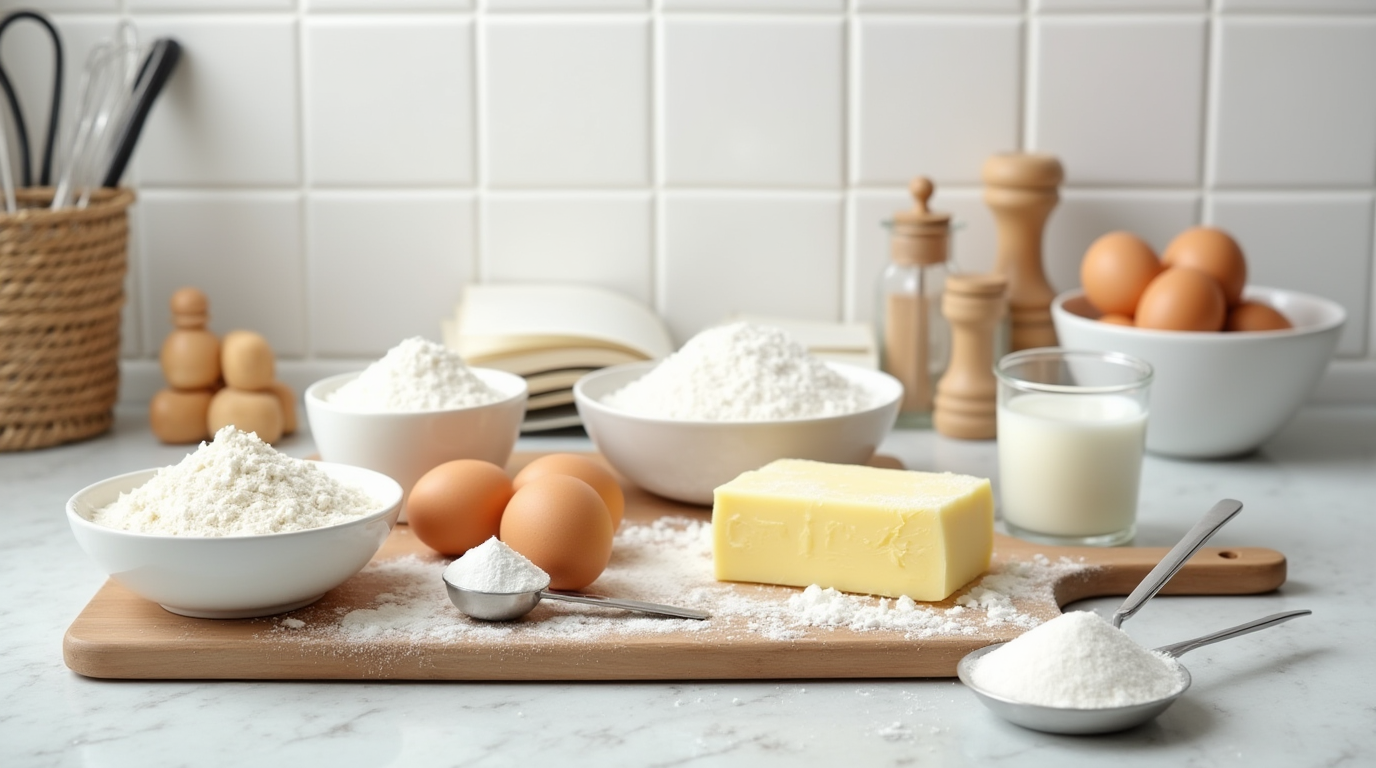Cake Ingredients Explained – What You Need for the Perfect Cake
A Sweet Journey Begins 🍰
Imagine the warmth of your kitchen filling with the rich aroma of a cake baking to golden perfection. Whether it’s for a birthday party, a family gathering, or simply a cozy Sunday afternoon, cakes symbolize joy and togetherness. But have you ever wondered why some cakes turn out light and fluffy, while others feel dense or dry?
The answer lies in understanding your cake ingredients. Each component plays a vital role, and mastering them can transform your baking from good to unforgettable.
Table of Contents
Let’s dive into the essential cake ingredients explained in a way that helps you bake the perfect cake every single time!
Essential Cake Ingredients for Perfect Results
Before you even preheat your oven, understanding the purpose of each cake ingredient is crucial. Every component contributes something unique to the final product.
Flour – The Foundation of Every Cake
Flour is the backbone of any cake. It provides structure through gluten formation when mixed with liquids.
- Common types of flour:
- All-purpose flour – versatile but may create a slightly denser crumb.
- Cake flour – lower protein content, perfect for tender, delicate cakes.
- Self-raising flour – includes added baking powder for convenience.
Pro Tip: Always sift your flour to avoid lumps and create a lighter cake texture.
Source: The Science of Good Cooking by Cook’s Illustrated
Sugar – Sweetness and Structure
Sugar isn’t just for sweetness. It also tenderizes the cake, locks in moisture, and aids in browning.
- Types of sugar:
- Granulated sugar – standard for most cakes.
- Brown sugar – adds moisture and a hint of caramel flavor.
- Powdered sugar – mainly used for frostings.
Baking Tip: Creaming butter and sugar properly incorporates air, which leads to a fluffy cake.
Eggs – The Binding Heroes
Eggs create stability and structure in your cake while contributing to moisture and richness.
- Standard: Large eggs are the norm in baking.
- Roles:
- Yolks add richness.
- Whites provide lift and lightness.
Pro Tip: Use room temperature eggs for better emulsification.
Fat – Butter, Oil, and Alternatives
Fat tenderizes cakes by coating flour proteins and preventing strong gluten formation.
- Options:
- Unsalted butter – preferred for its flavor control.
- Vegetable oil – excellent for moist cakes.
- Coconut oil or margarine – dairy-free alternatives.
Note: Butter brings unbeatable flavor, while oil often creates a softer crumb.
Leavening Agents – The Rise Makers
Without leaveners, your cake would turn into a heavy, rubbery mess.
- Main agents:
- Baking powder – double-acting is common.
- Baking soda – used when acidic ingredients like buttermilk are present.
Important: Freshness matters! Replace baking powder and soda every 6 months.
Liquid Ingredients – Moisture Magic
Liquids activate leaveners and hydrate dry ingredients.
- Common liquids:
- Milk – adds moisture and lightness.
- Buttermilk – tenderizes with a slight tang.
- Sour cream and yogurt – add richness and depth.
Tip: For ultra-tender cakes, use full-fat dairy options.
Flavorings – Enhancing the Experience
Flavorings transform a basic cake into a memorable masterpiece.
- Examples:
- Vanilla extract – essential for almost all cakes.
- Cocoa powder – for chocolatey goodness.
- Citrus zest – brightens flavors naturally.
- Spices like cinnamon or nutmeg – warm and cozy additions.
Reminder: Always choose pure extracts over imitation versions for the best flavor.
Cake Ingredient Substitutes You Should Know
Sometimes you need a quick fix when you’re missing an ingredient. Here are easy cake ingredient substitutes that still deliver great results:
| Missing Ingredient | Substitute Option | Notes |
|---|---|---|
| Buttermilk | Milk + 1 tbsp lemon juice/vinegar | Let sit 5 minutes |
| Eggs | 1/4 cup unsweetened applesauce per egg | Works for moist cakes |
| Butter | Equal amount of vegetable oil | Slightly different texture |
Pro Tip: Always test small batches when substituting to fine-tune taste and texture.
How to Measure Cake Ingredients Correctly
Accurate measurement is a cornerstone of successful baking. A few small errors can mean the difference between a fluffy masterpiece and a flat disappointment.
- Use a digital kitchen scale for best accuracy.
- Spoon and level method for flour: Lightly spoon flour into the cup and level it off without packing it down.
- Measure liquids at eye level using a liquid measuring cup.
- Sift dry ingredients like flour and cocoa powder to eliminate lumps and improve aeration.
Common Mistakes When Choosing Cake Ingredients
Baking can be unforgiving if you don’t pay attention to your ingredients. Avoid these common mistakes:
Using Expired Leavening Agents
- Baking powder and soda lose strength over time.
- Always check expiration dates before use.
Substituting Ingredients Without Adjustments
- Swapping butter for oil or buttermilk for regular milk alters both flavor and texture.
Skipping the Room Temperature Rule
- Cold ingredients don’t emulsify properly, leading to dense cakes.
Sample Perfect Cake Ingredient List
Ready to start baking? Here’s a classic vanilla cake ingredient list:
| Ingredient | Amount |
|---|---|
| All-purpose flour | 2 ½ cups |
| Baking powder | 2 ½ tsp |
| Salt | ½ tsp |
| Unsalted butter (room temp) | 1 cup |
| Granulated sugar | 2 cups |
| Large eggs | 4 |
| Vanilla extract | 2 tsp |
| Whole milk | 1 cup |
Tip: Always prep your ingredients before starting. Baking moves quickly once you begin!
Frequently Asked Questions About Cake Ingredients
What are the must-have cake ingredients for beginners?
Every beginner baker should keep flour, sugar, eggs, butter, baking powder, and vanilla extract stocked in their pantry.
Can I substitute oil for butter in a cake recipe?
Yes! Substituting oil for butter results in a moister cake, though you may lose some buttery flavor richness.
Why does my cake turn out dry even when I follow the recipe?
Common reasons include overbaking, over-measuring flour, or not using enough fat or liquid in your cake batter.
What is the best flour for making cakes?
Cake flour is ideal for tender, fluffy cakes. All-purpose flour works but requires careful handling to avoid toughness.
Conclusion: Bake with Confidence and Creativity
Now that you truly understand cake ingredients explained in depth, you’re ready to bake with confidence!
By mastering the role of each element, you elevate your cakes from ordinary to extraordinary.
So the next time you bake, do it with love, knowledge, and a sprinkle of creativity. Your perfect cake awaits!

